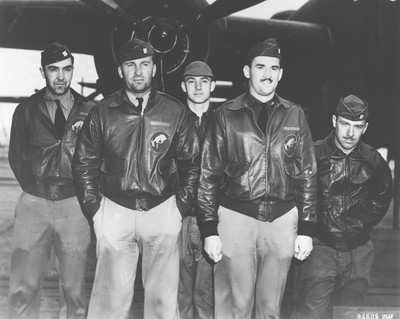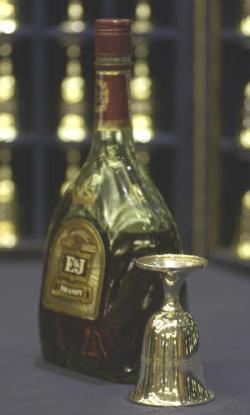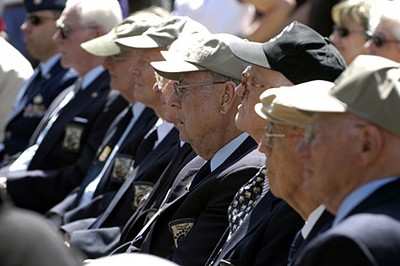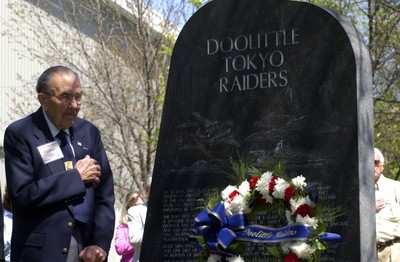WWII "Doolittle Raider" Was 90
Aero-News has learned America recently lost another of the famed
"Tokyo Doolittle Raiders," who helped boost American morale in the
early days of World War II with a surprise air attack on Japan.
Retired Lt. Col. Chase J. Nielsen, who spent a lifetime as an
advocate for American airpower, died March 23 at his home in
Brigham City, UT.

Born January 14, 1917 in Hyrum, UT Colonel Nielsen attended Utah
State University and graduated in 1939 with a bachelor of science
degree in civil engineering. In August 1939, he enlisted in the
U.S. Army Air Corps as a flying cadet. He was commissioned as a
second lieutenant in June 1941.
Colonel Nielsen, a lieutenant at the time, was the navigator of
"Crew #6" (shown above), one of 16 B-25 Mitchell bombers and
80 Airmen that launched from the deck of the USS Hornet on April
18, 1942. Led by legendary aviation pioneer Lt. Col. James H.
"Jimmy" Doolittle, the raid is one of the most studied and talked
about missions in the history of aerial warfare.

The raid was personally ordered by President Franklin D.
Roosevelt as response to Japan's surprise attack on Pearl Harbor
nearly five months earlier. Preparation for the attack was
conducted in secrecy at Florida's Eglin Air Force Base, and was
executed by loading 16 of the medium bombers onto the deck of the
USS Hornet, which departed from San Francisco, CA on April 2, 1942.
Although Doolittle and his crews had perfected the art of taking
off on a short field, returning to carrier was not an option.
 All 16 bombers made it to
their targets, however, they were forced to ditch or bail out over
or along the Chinese Coast because the US task force had been
spotted by Japanese picket boats, and Doolittle had decided to
launch early -- more than 600 miles from the Japanese mainland and
200 miles farther out than planned.
All 16 bombers made it to
their targets, however, they were forced to ditch or bail out over
or along the Chinese Coast because the US task force had been
spotted by Japanese picket boats, and Doolittle had decided to
launch early -- more than 600 miles from the Japanese mainland and
200 miles farther out than planned.
The original plan had called for the Raiders to launch during
the night and recover in China at dawn, but due to being spotted by
the picket boats, Doolittle's improvised plan had them taking off
in the early afternoon and landing in China at night. Further
complicating the recovery, an aircraft with a beacon that was
supposed to take off over China and guide the crews to friendly
airfields wasn't able to get airborne, so the Raiders were not able
to avoid areas where Japanese occupation forces were
concentrated.
Most of the aircraft were able to reach land, but two, including
Colonel Nielsen's, were forced to ditch off the coast of China. Two
men were killed in the ditching.
The eight men who survived were taken prisoner by the Japanese
forces and held in inhumane conditions from which only four of the
eight survived. Colonel Nielsen spent the next 40 months as a
prisoner of war, most of the time in solitary confinement, before
being rescued at the end of the war by an Office of Strategic
Services para-rescue team and brought back to the US.
Colonel Nielsen returned to Shanghai, China, in January 1946 to
testify in the International War Crimes Trials against his former
captors.
Colonel Nielsen became a member of Strategic Air Command in
March 1949 at Roswell AFB, NM, where he was assigned to the 509th
Bombardment Group -- the first group to be organized, equipped and
trained for atomic warfare. The assignment was fitting as SAC's
mission was to provide the United States with a long-range combat
capability.
During his decade with the major command, Colonel Nielsen helped
SAC develop key operational innovations, including radar navigation
bombardment, air refueling employing the flying boom, and
electronic countermeasures. He helped integrate "fail safe" and
other emergency war order procedures into SAC's unique set of
flight profiles.
Colonel Nielsen returned to the air while assigned to SAC and
reached more than 10,000 flying hours mostly in B-29s, B-50s, B-36s
and B-52s. His longest flight lasted 26 hours non-stop without
refueling from Okinawa, Japan, to Roswell, NM in a B-36.
Colonel Nielsen retired from the Air Force in 1961 as a
lieutenant colonel and began a career as an industrial engineer at
Hill Air Force Base, UT. He retired in 1981.
Colonel Nielsen's decorations include the Distinguished Flying
Cross, the Purple Heart with Cluster, the Air Force Commendation
Medal with Cluster, Outstanding Unit Award, Longevity Ribbon with
four Clusters, and the Breast Order of Pao Ting from the People's
Republic of China.
Of the 80 men who took part in the raid with Colonel Nielsen,
three were killed during the mission, five were interned in Russia
and eight became prisoners of war in Japan. Of those POWs, three
were executed by firing squad by the Japanese and another died in
captivity. Thirteen others would die later in the war. There are 14
Raiders alive today.
The Raiders are also famous for their annual reunions, which
began as a party hosted by Doolittle, in Miami Beach, FL in 1947.
The reunions have evolved into a gathering of one of the most elite
military fraternities in the world. At each reunion, surviving
Raiders meet privately to conduct a solemn "Goblet Ceremony."

After a role call followed by a toasting the Raiders who died
since their last meeting, they turn the deceased men's goblets
upside down. Each goblet has the Raider's name engraved twice -- so
that it can be read if the goblet is right side up or upside
down.
When only two Raiders remain alive, they will drink a final
toast using a vintage bottle of cognac.
The 80 goblets, which are normally on display at the National
Museum of the United States Air Force, are accompanied by US Air Force Academy
cadets. The Raider reunion will be held this year in
San Antonio from April 17 through 21.
At last year's 64th reunion, Colonel Nielsen (shown below) said,
"I am proud to have been on the Doolittle Raid. I am more proud to
have been of service to my country. I hope and I pray that what we
Doolittle Raiders have done will be an inspiration to you
people.

"I hope and pray that our young men and young women who are
serving in the service today will be protected; that they will live
their lives in accordance with the military rules and laws of war,
that they will do their best and that they will appreciate their
country and protect their flag as we tried to do ourselves,"
Colonel Nielsen said during reunion ceremony April 18.
Besides Colonel Nielsen, the other Raider who will be toasted
this year is former Staff Sergeant William L. Birch, a bombardier
on Crew #11, who passed away November 18, 2006, in Santa Ana,
CA.
(ANN salutes Lt. Col. Stephen Clutter, Air Force Print
News)
 ANN's Daily Aero-Term (05.05.25): Circle To Runway (Runway Number)
ANN's Daily Aero-Term (05.05.25): Circle To Runway (Runway Number) ANN's Daily Aero-Linx (05.05.25)
ANN's Daily Aero-Linx (05.05.25) NTSB Prelim: De Havilland DHC-1
NTSB Prelim: De Havilland DHC-1 Classic Aero-TV: The Boeing Dreamliner -- Historic First Flight Coverage
Classic Aero-TV: The Boeing Dreamliner -- Historic First Flight Coverage Airborne-NextGen 05.06.25: AF Uncrewed Fighters, Drones v Planes, Joby Crew Test
Airborne-NextGen 05.06.25: AF Uncrewed Fighters, Drones v Planes, Joby Crew Test







